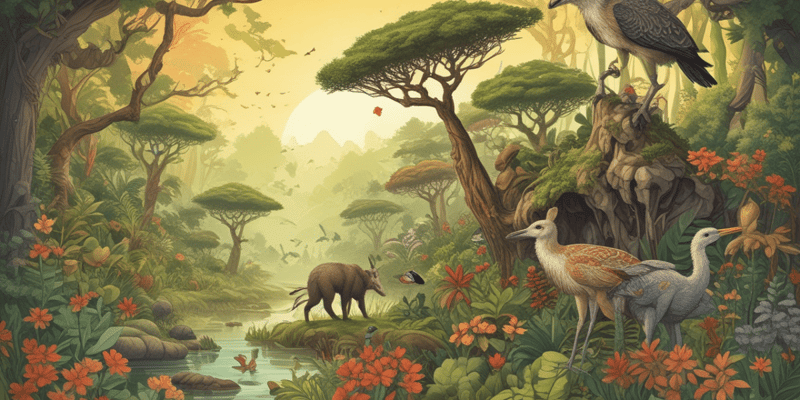12 Questions
What is the term that refers to the variety of life in all its forms?
Biodiversity
What is the highest level of organization in the living world?
Biosphere
What is one of the ecosystem services provided by biodiversity?
Food
What percentage of the ocean environment has been significantly altered by human activities?
66%
Who coined the term 'biodiversity'?
Edward O. Wilson
What is the term for the variety of all living organisms such as plants, animals, fungi, and microorganisms?
Organismal diversity
What is the main reason for the loss of biodiversity according to the text?
Human activities
Which type of diversity refers to the variety of genes within a species?
Genetic Diversity
What is the primary goal of conservation efforts in relation to biodiversity?
To protect habitats and prevent overexploitation of species
What is a factor that influences the distribution and abundance of species?
Climate
What is the result of human activities such as deforestation, pollution, and overfishing?
A loss of biodiversity
What type of diversity refers to the variety of different species within a given area or ecosystem?
Species Diversity
Study Notes
Living World: Understanding Biodiversity
Biodiversity, a term coined by Edward O. Wilson, refers to the variety of life in all its forms, from the microscopic to the largest ecosystems. It includes the variety of all living organisms such as plants, animals, fungi, and microorganisms, as well as the genetic diversity within and between these groups. This article aims to provide a comprehensive understanding of biodiversity within the context of the living world, focusing on the different types of ecosystems, the importance of biodiversity, and how it is classified.
Ecosystems and the Biosphere
An ecosystem consists of all the living things in a particular area together with the abiotic, non-living parts of that environment such as nitrogen in the soil or rain water. At the highest level of organization, the biosphere is the collection of all ecosystems, and it represents the zones of life on Earth. It includes land, water, and the atmosphere.
The Importance of Biodiversity
Biodiversity is crucial for the functioning of ecosystems and the wellbeing of humans. It provides various ecosystem services such as food, water, and air purification, as well as cultural and recreational benefits. However, human activities have led to a significant loss of biodiversity, with three-quarters of the land-based environment and roughly 66% of the ocean environment being significantly altered. Climate change worsens this impact, and humans have overfished the oceans, cleared forests, and polluted water sources.
Classification of Biodiversity
Biodiversity can be classified in several ways, including:
-
Genetic Diversity: This refers to the variety of genes within a species, which can be influenced by genetic drift, gene flow, genetic mutation, and natural selection.
-
Species Diversity: This refers to the variety of different species within a given area or ecosystem.
-
Ecological Diversity: This refers to the variety of ecological niches and interactions between species within an ecosystem.
-
Geographic Diversity: This refers to the spatial distribution of species across the Earth, with some regions having higher levels of biodiversity than others.
Factors Influencing Biodiversity
Several factors influence biodiversity, including:
-
Climate: Changes in temperature and precipitation patterns can affect the distribution and abundance of species.
-
Habitat: The availability and quality of habitats for species play a significant role in their survival and reproduction.
-
Genetic Diversity: The genetic variation within species can influence their ability to adapt to changing environments and resist diseases.
-
Human Activities: Human activities such as deforestation, pollution, and overfishing can lead to a loss of biodiversity.
Conservation of Biodiversity
Conservation efforts are crucial for maintaining biodiversity. This can include the protection of habitats, the prevention of overexploitation of species, and the promotion of sustainable resource use.
In conclusion, biodiversity is a fundamental aspect of the living world, and its conservation is essential for the wellbeing of humans and the planet. Understanding the different types of biodiversity and the factors that influence it can help inform effective conservation strategies.
Explore the concept of biodiversity, its importance, and its classification into genetic, species, ecological, and geographic diversity. Learn about the factors influencing biodiversity and the conservation efforts necessary to maintain it.
Make Your Own Quizzes and Flashcards
Convert your notes into interactive study material.
Get started for free



